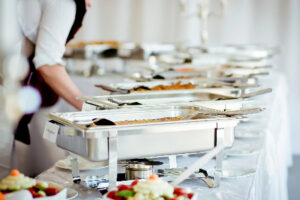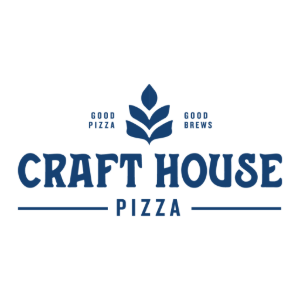Expanding your restaurant’s revenue streams and reaching a wider customer base is an essential aspect of a thriving food service business and to create an even more compelling food service franchise offering. One strategic approach to achieve this is by setting up a catering program for your restaurant. Catering not only allows you to serve customers beyond your restaurant’s dining area but also provides opportunities for growth and brand recognition. In this comprehensive guide, we’ll explore the steps and strategies to successfully establish a catering program for your restaurant and your food service franchise model.
1. Research and Market Analysis
Before you jump into the world of catering, it’s crucial to conduct thorough research and market analysis to lay the foundation for your catering program.
a. Identifying Your Target Market
Determine the target audience for your catering services. Are you catering to corporate clients, private events, weddings, or individuals looking for meal delivery? Tailor your offerings and marketing strategies to cater to the specific needs and preferences of your target market.
b. Analyzing the Competition
Study your local competitors in the catering industry. Identify their strengths and weaknesses, as well as the gaps in their services. This analysis will help you differentiate your catering program and position it as a unique and appealing choice.
c. Understanding Your Local Regulations
Familiarize yourself with the local regulations and requirements for running a catering business. This may include permits, licenses, food safety regulations, and zoning ordinances. Compliance is essential to avoid legal issues.
2. Creating a Catering Menu
Developing a compelling and diverse catering menu is a key component of your catering program.
a. Menu Development
Design a menu that reflects your restaurant’s style and expertise. Consider offering a range of options, including appetizers, entrees, desserts, and beverage selections. Create packages for various types of events and customize menus to accommodate dietary restrictions or special requests.
b. Pricing Strategies
Determine your pricing strategy for catering services. Calculate costs accurately, including ingredients, labor, and overhead, to set competitive yet profitable prices. Consider different pricing structures, such as fixed per-person rates, tiered pricing, or à la carte options.
c. Dietary Restrictions and Special Requests
Incorporate flexibility in your catering menu to accommodate dietary restrictions and special requests. Offer vegetarian, vegan, gluten-free, and allergen-free options. Train your kitchen staff to prepare these dishes with care to avoid cross-contamination.
3. Staffing and Training
As you venture into catering, building a capable team and providing training are essential steps.
a. Building a Catering Team
Assign roles and responsibilities to your existing staff or hire additional team members dedicated to the catering program. These roles may include a catering manager, chefs, servers, and delivery personnel.
b. Training Staff
Ensure that your catering staff receives proper training in food preparation, presentation, and customer service. Training should also cover safety and hygiene standards. Consistency in service is key to your catering program’s success.
c. Hiring Additional Help
Depending on the scale of your catering program, you may need to hire additional staff on a temporary or part-time basis to handle larger events or peak periods.
4. Marketing and Branding
Effective marketing and branding strategies will help promote your catering program and attract customers.
a. Creating a Catering Brand
Establish a unique brand identity for your catering services. This may include a separate name, logo, and branding materials that align with your restaurant’s image.
b. Promotional Materials
Develop promotional materials, such as brochures, flyers, and business cards, to distribute to potential clients. Highlight your catering menu, services, and competitive advantages.
c. Online Presence
Leverage your restaurant’s website and social media channels to showcase your catering program. Create an easy-to-navigate catering section on your website, providing information on menus, pricing, and contact details. Share high-quality photos of your catering offerings on social media platforms to entice potential clients.
5. Logistics and Equipment
The logistics and equipment for your catering program play a critical role in its success.
a. Catering Equipment
Invest in catering-specific equipment, such as chafing dishes, serving platters, utensils, and transport containers. Ensure that your kitchen is equipped to handle catering orders efficiently.
b. Transportation
Consider the transportation needs for your catering deliveries. This may involve investing in delivery vehicles or partnering with local delivery services.
c. Inventory Management
Implement efficient inventory management systems to track catering supplies, ingredients, and non-perishable items. Avoid last-minute shortages by maintaining adequate stock.
6. Ordering and Payment Systems
Implementing user-friendly ordering and payment systems is crucial for customer convenience.
a. Online Ordering
Offer an online ordering system on your website, allowing customers to browse menus, customize their orders, and submit catering requests easily. Ensure secure and user-friendly payment options.
b. Payment Methods
Accept various payment methods, including credit cards, checks, and online payment platforms, to accommodate diverse customer preferences.
c. Invoicing and Billing
Provide clear and detailed invoices to clients, including itemized costs, fees, and payment instructions. Establish a transparent billing process for accuracy and trust.
7. Delivery and Presentation
The delivery and presentation of your catering services significantly impact customer satisfaction.
a. Transportation and Packaging
Invest in reliable transportation for catering deliveries, ensuring that the food arrives at the event location in optimal condition. Use sturdy, insulated containers to keep hot dishes hot and cold dishes cold.
b. Presentation and Customer Experience
Pay attention to the presentation of your catering services, including plating, garnishing, and serving. Create an outstanding visual experience that aligns with your restaurant’s quality standards. Train your catering staff to provide excellent customer service at events.
c. Food Safety and Hygiene
Maintain the highest food safety and hygiene standards throughout the catering process, from food preparation in your kitchen to on-site service. Train your staff in safe food handling practices and ensure compliance with health regulations.
8. Quality Control and Feedback
Consistency in food quality is paramount in catering.
a. Consistency in Food Preparation
Maintain consistency in food preparation by following standardized recipes and processes. Monitor food quality to meet the high standards of your restaurant.
b. Gathering Customer Feedback
Solicit feedback from catering clients to understand their experience and identify areas for improvement. Use surveys, reviews, and direct communication to gather valuable insights.
c. Continuous Improvement
Act on customer feedback and implement changes and improvements to enhance your catering program continually. Regularly assess your processes and menu to stay competitive and meet evolving customer preferences.
9. Legal and Regulatory Compliance
Ensuring legal and regulatory compliance is essential for a successful catering program.
a. Permits and Licenses
Obtain the necessary permits and licenses to operate a catering program. These may include catering licenses, health permits, and alcohol licenses, depending on the services you offer.
b. Insurance and Liability
Secure comprehensive insurance coverage for your catering operations, including liability insurance to protect against potential claims or accidents.
c. Compliance with Health and Safety Standards
Adhere to health and safety standards mandated by local and national health authorities. Maintain stringent hygiene practices, safe food handling, and sanitation protocols.
10. Scalability and Growth
As your catering program gains momentum, consider the potential for growth and scalability.
a. Expanding Your Catering Operations
Explore opportunities to expand your catering services, such as adding new menus, diversifying into different types of events, or extending your delivery range.
b. Exploring New Markets
Look for opportunities to enter new markets and reach a broader customer base. Consider catering to corporate clients, weddings, social events, and large-scale gatherings.
c. Building Long-Term Relationships
Foster strong relationships with your catering clients to encourage repeat business and referrals. Offer loyalty programs or incentives to reward ongoing support.
Setting up a catering program for your restaurant can be a lucrative endeavor that expands your reach, builds your brand, and enhances your revenue. It allows you to cater to diverse customer needs, from corporate events to private parties, and meet the increasing demand for high-quality catering services. By conducting thorough research, developing a captivating menu, building a competent team, implementing effective logistics, and ensuring compliance, you can establish a successful catering program that satisfies customers and drives growth for your restaurant. With careful planning, consistent quality, and a commitment to excellent customer service, your catering program can become a prominent revenue stream and an integral part of your restaurant’s success.
For more information on how to build a solid catering program for your restaurant and how to franchise your restaurant business, contact Franchise Marketing Systems (FMS Franchise): www.FMSFranchise.com














